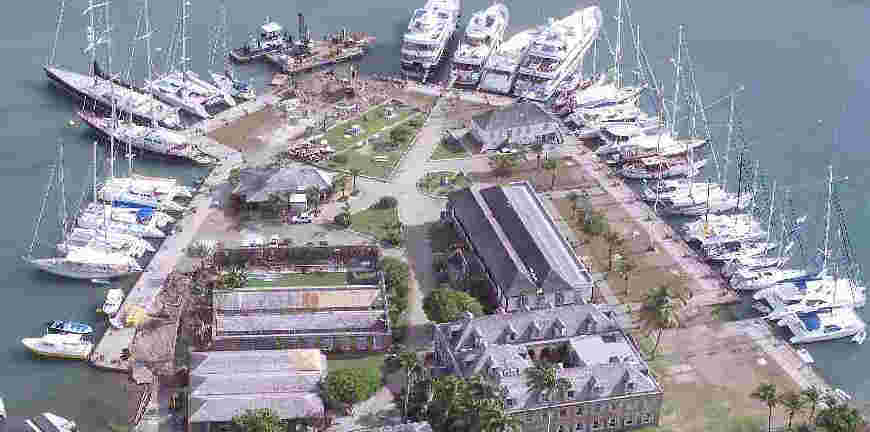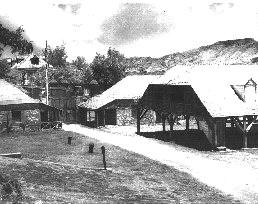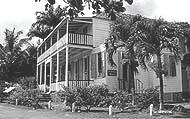Back to HOME PAGE
.jpg)
His Majesty's Antigua Naval Yard at English Harbour dates from 1725. Its function was to maintain the Royal Naval warships that captured valuable sugar islands of the Eastern Caribbean thus cutting off enemy trade and increasing Britain's own wealth.
By 1889, the Yard had completely wound down, and released by the Admiralty to the Colonial Government in 1906.
From the beginning of restoration in 1951, the yard became known as Nelson's Dockyard in honour of Admiral Horatio Nelson who had served as a Captain from 1784-87.
The DOCKYARD MUSEUM in the Naval Officer's House interprets the story of English Harbour and of the people that toiled in this famous Georgian Royal Naval Yard. It also explains the 20th century return of sailing ships and the aims and aspirations of Nelson's Dockyard National Park. There is also a small "Nelson's Room" with a life sized portrait of Nelson researched through archaeological means.
A LIBRARY, with copies of original documents and a database of Caribbean naval history, is available for researchers.
Tel: 1 268 460-1379 or fax: 460-1516 or E-Mail c/o: mailto: natpark@candw.ag
THE FIRST PEOPLE, TOOLS & BOATS - The harbour's history started about 500 BC when Archaic Indians settled in the harbour living on marine resources. Later, around 500 AD, the Arawak Indians actually lived where the Dockyard is today and at Freeman's Bay near the entrance to the harbour. Their artifacts are shown in the Museum.THE FIRST SHIP ... A YACHT - The first recorded naval ship was when a yacht, chartered to the Governor of the Leeward Islands "to chase ye pirates", was safe in a hurricane in 1671. Warships then began to use the harbour for careening and self refits. It was not until about 50 years later that the first buildings were established on the east side of the harbour (where the yacht slipway is today).
BLACK LABOURERS - The Dockyard was used by the Royal Navy during the French wars that persisted on and off throughout the 18th century until peace was finally declared in 1815. During its heyday the labour force was 5 officers and 327 men, most of whom were enslaved African shipwrights, caulkers, sail makers and labourers.
THE OFFICERS & SHIPS - Many famous officers visited Antigua including Admirals Rodney, Cochrane, Hood, and Nelson. The latter had been the 26 year old Captain of HMS Boreas in 1784. The Americans had recently become independent and thus a foreign nation. The Navigation Act prohibited trade with foreign countries using foreign or American ships. Nelson therefore became unpopular with Antiguans for he enforced the Navigation Act. The ships most often seen under repair in English Harbour were frigates, brig-sloops, schooners and cutters.
DECAY & LATER RESTORATION - After the peace of 1815, the running down period commenced, so that by 1889 the station was officially closed down. Then decay of the buildings set in. In 1931, the colonial Governor took pity on this most historic site and organised funding from a Canadian insurance company to repair some of the buildings. Tourism and yacht chartering had not yet started, so restoration failed. In 1951, however another Governor founded the Friends of English Harbour Society and Lady Churchill sponsored an Appeal Committee in London, and from then on restoration grew from strength to strength..
TODAY - The National Parks Authority has full responsibility for the running and well being of the Dockyard and environs. Much funding has been forthcoming from the Canadian International Development Agency and the British Development Division. In 2004, restoration of the stone wharfs was accomplished with funds from the European Union and the Government of Antigua and Barbuda. English Harbour is being operated as a successful tourist attraction and as a yacht marina.
There are two bays to this building, built at different times. The upper walls of this store were considered unsafe in 1949, so were dismantled.
Above the Boat House was the Joiner's and Turner's Loft. The building is near the Main Gate and once held the Yard clock high up on the south side and there was once a small "Engine House" for fire engines below. Bare boat charter offices are below.
On the top floor were the engineer's offices and below pitch, tar & turpentine was stored over brick-lined pits. Today it houses the Admirals Inn.
|
Seaman's Galley
Cordage Store
Mast House |
 |
Pay Office
Officer's Quarters
Copper & Lumber Store |
|
The stone wharf almost completed, December 2003 |
||
 |
 |
|
| Dockyard Gate & Joiner's Loft in 1950 | Cordage & Canvas Store in 1949 | |
 |
 |
|
| The 1855 Naval Officer's House (Museum) in 2000 | The 1797 Boat House & Sail Loft pillars in 1954 |
There is a small Research Library upstairs of the Museum with documents appertaining to the history of the Dockyard.
Some documents:
Naval Officer’s Antigua Navy Yard Correspondence in the Dockyard Library:
Vol. I - From Naval Officer Antigua Yard 1755 - 1794
Vol. II - ditto Jun 1795 - May 1800
Vol. III - ditto May 1800 - Jun 1810
Vol. IV - ditto Jun 1810 - Jan 1824
Vol. V - Navy Board 1758 - Dec 1781
Jan 1824 - 1825
Vol. VI - ditto Dec 1781 - 1784 (Some ref. Capt. Nelson)
Vol. VII - Expense Book (on ships under repair) 1781.
Extracts from Letter Books of Hood & Cochrane, 1803 - 1805.
C-in-C. Leeward Islands correspondence to the Commissioner, Antigua Yard.
Vol. I - 1803 Hood
Vol. II - 1805 Cochrane.
Extracts from the Journal of Boatswain Francis Fox of the Antigua Naval Yard, 1820 – 1823.
Several volumes of Yacht Visitor's books, 1950's to c. 1970.
A drawer of maps, plans and large documents.
Much of the above material is indexed in a Naval History database of about 1,925 records.
There are also databases of Dockyard building histories and Dockyard employees.
The Museum possesses the valuable Weiss archive of Antiguan Geology left by a researcher from DeKalb University.
An archaeological research centre collects, catalogues and preserves artifacts from English Harbour and those found when the stone wharf was restored in 2004. This room may be visited by appointment.
There is well stocked gift shop attached to the Dockyard Museum in the Naval
Officer's House. It carries old maps, plans and charts of Antigua as well as a
quantity of local handicrafts.
Buy a memento of your visit of this famous
heritage site, by doing so you will be supporting it!
Some of the items in stock are:-
Today the Dockyard is part of a large National Park and a historic landmark of the Caribbean. It is administered by the National Parks Authority.
Some of its aims and aspirations are as follows:-
Chairman NPA:
Ms. Valerie Hodge
Parks Commissioner: Mrs. A.
Martin,
Archaeologist: Dr. Reg A. Murphy.
Box 1283,
St. John's, Antigua, West Indies.
Tel: (268) 460-1379 Fax: (268) 460-1516
E-mail: natpark@candw.ag
Over the last 300 years or so the harbour has been known for its safety. It is not surprising, therefore, that sailing ships have returned and now, together with Falmouth Harbour, it has become a world renowned yacht centre. In December each year, a Yacht Show takes place and in April, the Harbour becomes the headquarters for Antigua Sailing Week one of the ten largest regattas in the world, sponsored by the Antigua Hotel Association . The Antigua Yacht Club sponsors the famous Classic Yacht Regatta also held in April.
Some of the facilities available to visiting yachtsmen are:
|
A marine railway Engineering shops Ship chandlers Inflatable service Yacht brokerage Sail makers Water makers Hotels Many restaurants Web Site Design Car rental Engineering Welding Travel Agents Post Office Woodworking Painting & spraying Pottery Veterinarian Laundry & Laundresses |
Electronic repairs Diesel specialists Spare part orders Three marinas Supermarkets Gelato Ice Cream Cake maker Liquor stores Wine merchants Pharmacy Nautical books Yacht storage Salvage & Towing Water taxis Florist Massage & Therapy Shipwrights Carpet cleaners Marine surveyors Art Galleries |
Cellular phones Refrigeration Nautical clothing Marine photographer Yacht club Laser Racing Massage, hairdressing Acupuncture Yoga classes Weather service Tennis & squash Computer repairs Computer sales Internet access Video rentals Signs & Lettering Bank Rigging services Osmosis treatment Real estate |
To Top